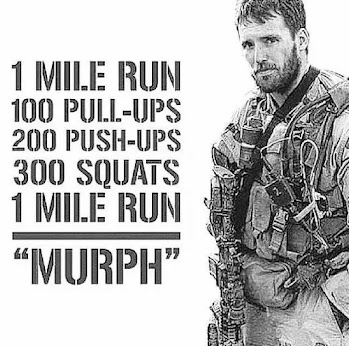Memorial Day is just around the corner (May 27th if you’ve forgotten), and whether you’re new to CrossFit or not, you’ve probably heard about Murph at some point. In class we will be completing Murph B day May 24th and A day May 28th.
In case you’re unfamiliar, “Murph” is a classic CrossFit workout known as a Hero WOD. Hero WOD’s are made by CrossFit to honor the men and women that have fallen in the line of duty. This one is specifically to honor Navy Lieutenant Michael Murphy, who was killed in action in Afghanistan on June28th, 2005.
This workout itself was Michael’s favorite workout to do, which at the time referred to it as “Body Armor”, hence the 20 lb vest or body armor as part of the workout prescription. So, every year, CrossFitters synonymously around the world pay special tribute to Lieutenant Murphy by joining together and suffering through this workout.
WHY DO WE DO MURPH?
Hero WOD’s are not uncommon in the CrossFit community. Besides the story of an amazing human being who gave his courage and ultimate sacrifice for his team and country (which we’re about to get to), it also gives us a chance to pay tribute to other Hero WOD’s such as J.T., Michael, Randy, and Nate. CrossFit still makes new Hero workouts to this day.
“These men were fathers, husbands and sons. They were brothers to their fellow SEALs. They were also CrossFitters. In their actions, these men embodied the values and spirit of true heroes, and to immortalize their courage, bravery and self-sacrifice, the CrossFit Hero workouts were created.”
–Russel Berger, CrossFit
So what made Lieutenant Murphy’s story so impactful? Here’s an excerpt about what went down in Afghanistan in June 2005:
On June 28, 2005, Lt. Murphy was the officer-in-charge of a four-man SEAL element in support of Operation Red Wing tasked with finding key anti-coalition militia commander near Asadabad, Afghanistan. Shortly after inserting into the objective area, the SEALs were spotted by three goat herders who were initially detained and then released. It is believed the goat herders immediately reported the SEALs’ presence to Taliban fighters.
–
A fierce gun battle ensued on the steep face of the mountain between the SEALs and a much larger enemy force. Despite the intensity of the firefight and suffering grave gunshot wounds himself, Murphy is credited with risking his own life to save the lives of his teammates. Murphy, intent on making contact with headquarters, but realizing this would be impossible in the extreme terrain where they were fighting, unhesitatingly and with complete disregard for his own life moved into the open, where he could gain a better position to transmit a call to get help for his men.
–
Moving away from the protective mountain rocks, he knowingly exposed himself to increased enemy gunfire. This deliberate and heroic act deprived him of cover and made him a target for the enemy. While continuing to be fired upon, Murphy made contact with the SOF Quick Reaction Force at Bagram Air Base and requested assistance. He calmly provided his unit’s location and the size of the enemy force while requesting immediate support for his team. At one point, he was shot in the back causing him to drop the transmitter. Murphy picked it back up, completed the call and continued firing at the enemy who was closing in. Severely wounded, Lt. Murphy returned to his cover position with his men and continued the battle.
–
As a result of Murphy’s call, an MH-47 Chinook helicopter, with eight additional SEALs and eight Army Night Stalkers aboard, was sent in as part of the QRF to extract the four embattled SEALs. As the Chinook drew nearer to the fight, a rocket-propelled grenade hit the helicopter, causing it to crash and killing all 16 men aboard.
–
On the ground and nearly out of ammunition, the four SEALs, continued to fight. By the end of a two-hour gunfight that careened through the hills and over cliffs, Murphy, Gunner’s Mate 2nd Class (SEAL) Danny Dietz and Sonar Technician 2nd Class (SEAL) Matthew Axelson had fallen. An estimated 35 Taliban were also dead. The fourth SEAL, Hospital Corpsman 2nd Class (SEAL) Marcus Luttrell, was blasted over a ridge by a rocket-propelled grenade and knocked unconscious. Though severely wounded, the fourth SEAL and sole survivor, Luttrell, was able to evade the enemy for nearly a day; after which local nationals came to his aide, carrying him to a nearby village where they kept him for three more days. Luttrell was rescued by U.S. Forces on July 2, 2005.
–
By his undaunted courage, intrepid fighting spirit and inspirational devotion to his men in the face of certain death, Lt. Murphy was able to relay the position of his unit, an act that ultimately led to the rescue of Luttrell and the recovery of the remains of the three who were killed in the battle.
–
Lt. Murphy was buried at Calverton National Cemetery less than 20 miles from his childhood home. Lt. Murphy’s other personal awards include the Purple Heart, Combat Action Ribbon, the Joint Service Commendation Medal, the Navy and Marine Corps Commendation Medal, Afghanistan Campaign Ribbon and National Defense Service Medal.


No comments:
Post a Comment